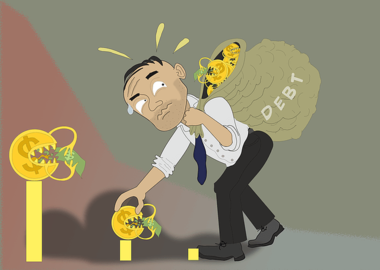Corporate debt and the U.S. government

By Bill Schmick
The Retired Investor
The pandemic and its impact on the American economy required a drastic response from both the Federal government and the Federal Reserve Bank. One of the most controversial, but necessary, steps taken by the Fed was to not only purchase private sector debt, but implicitly guarantee that debt.
In addition, both fiscal and monetary stimulus has been pouring into the economy in an effort to defend jobs and stave off bankruptcy for thousands of small businesses. While some worry about the inflationary effects this may have down the road, the attitude of most economists is that we will worry about that later, if it becomes a problem.
In my last column, I explained that as far as Fed stimulus is concerned, central bank money is not necessarily inflationary, it simply swaps assets for central bank reserves within the financial system’s balance sheet. Inflation rarely occurs, unless banks take some of their money and decide to lend it to you and me. That’s called private money. The faster it circulates (called velocity) from one person or entity to the next, the higher the chances that inflation will rise.
Over the last decade, lending institutions, generally, have been loath to lend to the private sector because they feared that borrowers would not be able to pay back their loans. But what happens if that lending risk were to disappear? That is what may be happening in today’s markets under the government’s new loan programs. By purchasing or promising to purchase, corporate debt, bad or otherwise, within the U.S. financial system, banks are now presented with a no-risk, win/win proposition of lending.
Why not lend as long as the government is willing to pick up the tab if things go bad? So, what if a company can’t repay its loans? It wouldn’t necessarily need to declare bankruptcy. The government could simply extend payments, lower interest rates, or do whatever it takes to keep the debtor in business. Right now, for example, much of the payroll protection loans will be forgiven if the guidelines are followed. Why not extend the same terms for other causes?
Would that ultimately mean the amount of private and public debt grows even larger than it already is in this country? Well, yes, but according to Modern Monetary Theory (MMT) that’s okay too. MMT argues that as long as a country can continue to control and print its own currency, there is no chance that a country can go bankrupt.
In fact, the more a country spends, the better off it will be, according to MMT theorists. If inflation were to result, all the central bank would need to do is hike interest rates. Therefore, there would be no need to adhere to traditional economic theory.
Think of it--politicians would have a field day. All their political popular causes would suddenly be possible--refinancing, reconstruction, environmental, even equality loans—all guaranteed by the government. A version of this concept (another $1 trillion in fiscal stimulus) is expected to be passed by Congress next month.
Traditional economic theory would argue that all that borrowing would create a ballooning deficit and out of control deficits would require a reduction in spending and/or an increase in taxes. Otherwise, inflation would explode, interest rates would skyrocket, the economy would tank, and the government’s debt payments would go through the roof.
Both theories, however, have an Achilles heel when it comes to inflation. The last four years have revealed to us just how much influence politics have on what we thought was our independent central bank. Imagine the outrage from every political corner if the Fed were to raise rates, no matter the reason.
In addition, the government’s announced plans to provide a backstop to corporate debt, should result in an uptick in bank lending. It won’t be much at first, since banks will need to feel their way into renewed lending before expanding on the practice. But there is a lot of cash just looking for a home right now. Between $4 and $5 trillion is sitting in money market funds, according to Refinitiv Lipper, as of last month. There is also another $2 trillion in cash parked within the banking system.
If I am right, over the remainder of this year, and into next, I expect to see loans increase substantially, unleashing first a trickle and then an avalanche of money, which should flow into the real economy. That is what the central bank, the federal government and everyone else is hoping for. My concern is that we may see the velocity of money take off as well. If it does, and inflation does begin to rise, will we be prepared for the outcome?
Bill Schmick, the “Retired Investor." worked in the financial services business for over 40 years. He is now focusing on writing about the financial markets and the needs of retired investors like himself. His goal is to make the last thirty-plus years of your life the very absolute best.
The Gayly. 6/25/2020 @ 11:22 a.m. CST.





